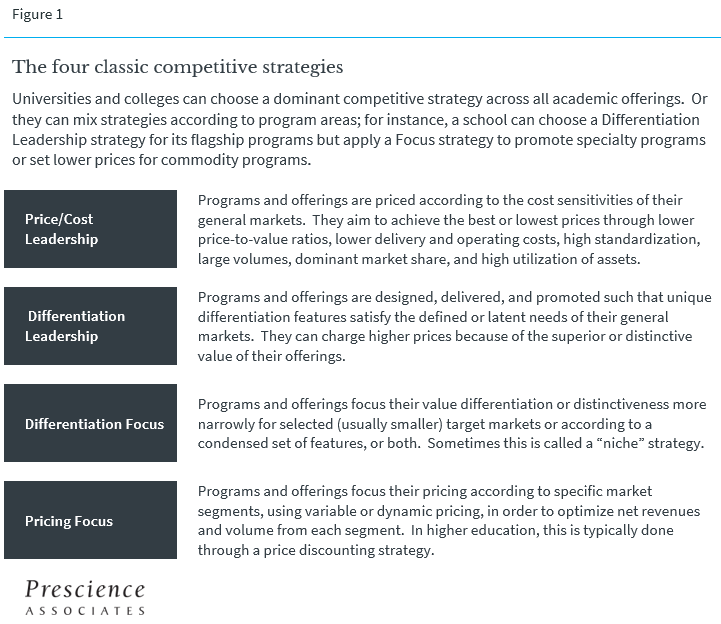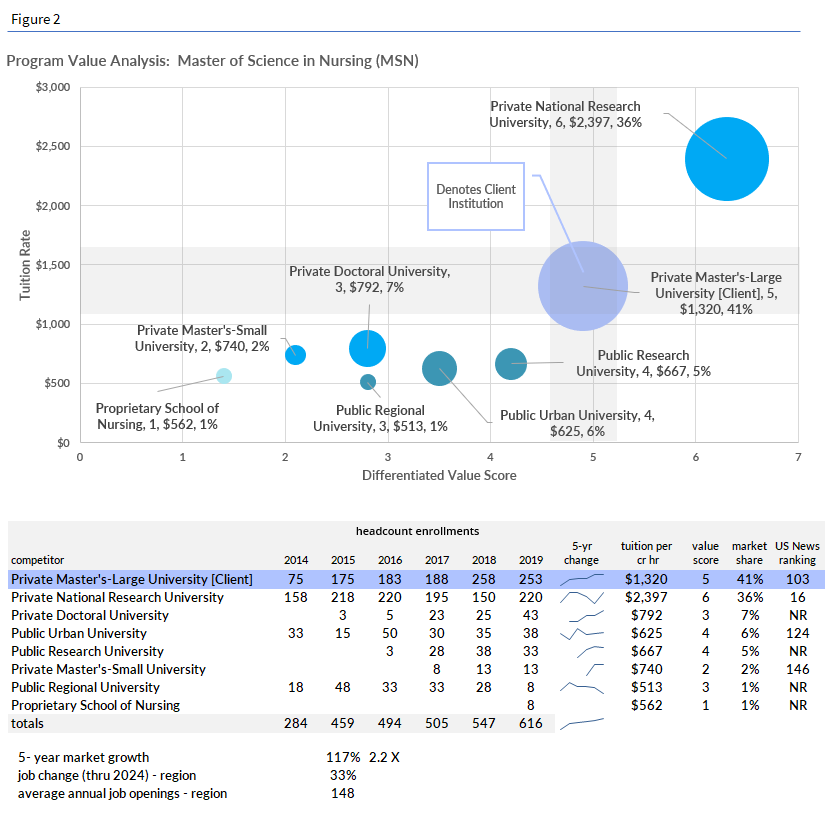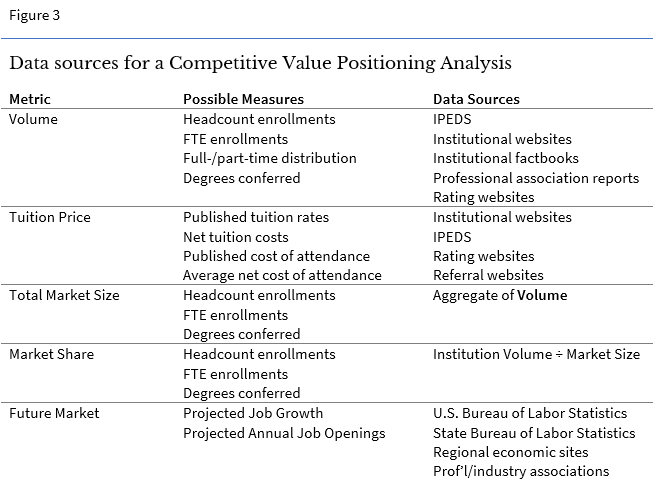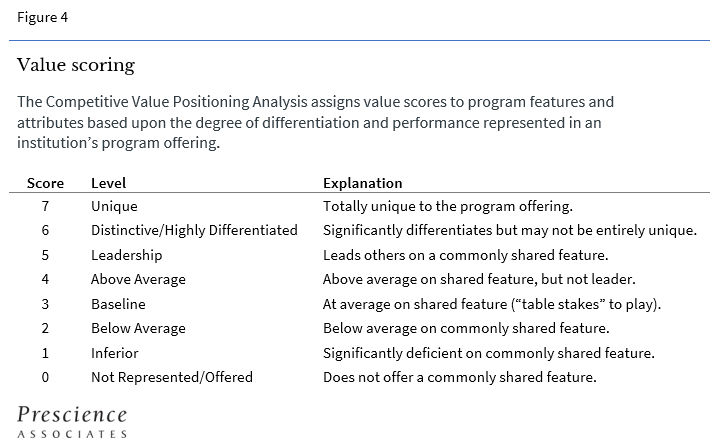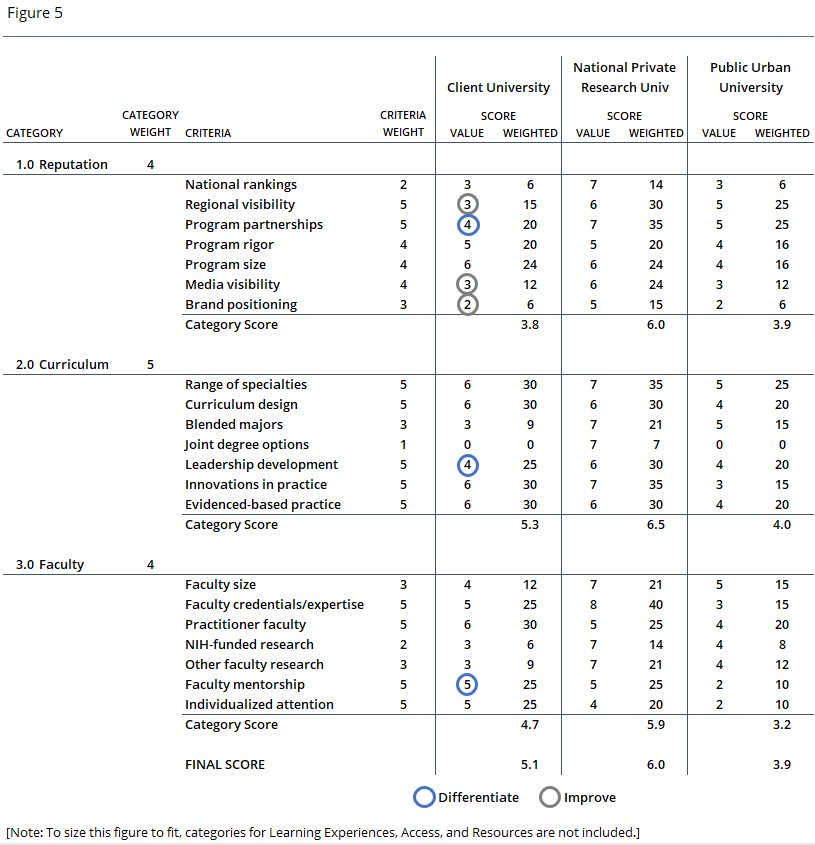The Competitive Value Positioning Analysis Tool
DOWNLOAD ARTICLE
Market-sensitive universities and colleges will need to make intelligent choices about competitive strategies and positioning for their academic programs and offerings. We have prototyped an elegant decision-support tool to inform those choices.
Introduction: Competitive Positioning and Strategy
Already intense competition for students will become fiercer in the post-COVID19 “next normal.”
How can market-sensitive universities and colleges choose the best competitive strategy (figure 1) for their academic programs and offerings?
We have partnered with some of our forward-thinking clients to prototype the Competitive Value Positioning Analysis tool as a straightforward way to inform strategy decision making.
Overview: The Competitive Value Positioning Analysis
To illustrate our methodology, we use the case study of a Master of Science in Nursing (MSN) program offered by a private, regional large-master’s university located in a mid-sized metropolitan area.
As shown in its Dashboard (figure 2), the Competitive Value Positioning Analysis captures six key metrics:
- Total Market Size (five-year trends);
- Volume (headcount enrollments);
- Market Share;
- Tuition Price;
- Differentiated Value Score; and
- Future Market (projected job change and annual openings).
[Note: The case study is based upon actual data and analyses conducted for our client, a private, regional large-master’s university, which engaged us for a program of brand and competitor research, business planning and new program development, and decision analytics and forecasting. To protect our client’s confidentiality, we have randomized data collected for the engagement and masked the identities of competitor institutions.]
The measures can change depending on the nature of the program offering. Volume might be stated as FTE enrollments or disaggregated for full- and part-time students. For undergraduate programs, net tuition costs after discounts can be a better measure than published tuition rates. Dashboards can be customized to drill-down on measures, for instance to isolate metrics according to seated, online, or hybrid delivery.
We designed the tool such that data sources are readily available from public sources or web searches (figure 3).
Introducing the Differentiated Value Score
Most competitive positioning analyses lack a metric that represents the differentiated value of an academic offering—and hence fail to account for how a university or college competes on value. To address this design exclusion, we introduce the Differentiated Value Score in our prototype. It is calculated across two dimensions:
- Weighted scores of importance of the features of the program area under review; and
- Scores of attribution or performance for the client’s and competitors’ programs. (See figure 4 for the scoring system across levels of differentiation.)
We created a Scorecard to record ratings and calculate institutional scores (see figure 5 for a partial snapshot). A blank Scorecard (as well as full example) can be downloaded here.
Determining Differentiated Value Scores is equal parts science and art. For this case, we first studied the designs and promotional language of the client’s and competitors’ MSN programs to derive a set of features and components that represent educational value. We then scanned knowledge bases of professional associations in nursing, as well as rating systems (e.g., US News rating methodology for graduate nursing programs), for additional features. Finally, as part of a brand study for our client, we asked current and potential students, alumni, and employers to rate possible program attributes for importance.
The client’s nursing faculty and staff actively participated throughout this process, offering in-depth knowledge of their own program’s differentiation, their competitors’ value positioning, and current and future requirements for the profession. In fact, one of the most salient benefits of our scoring methodology was the deep discussions it engendered among faculty about what aspects of educational value are most important to students and employers and where their program excels or needs improvements.
Determining a competitive strategy
The Competitive Value Positioning Analysis found this about our client’s MSN program:
- Market share. It has captured superior market share in its regional market because of steady growth over the past five years.
- Positioning against downstream institutions. It competes against a group of private, public, and proprietary programs that charge lower prices but also exhibit lower value.
- Positioning against the major competitor. Its major competitor is a highly regarded private national research university, whose strong program and faculty resources, clinical and research partnerships, and program reputation and rankings earn it the right to charge a premium price.
- Market Forecasts. The number of total jobs and annual openings for MSN nurses will continue to grow in the metropolitan region.
The positioning analysis led our client institution to choose a Focused Differentiation competitive strategy. The university decided to selectively strengthen certain capabilities and resources that are most important in the regional market, such as strong clinical partnerships, regional brand visibility, and value-added features around leadership development and faculty mentorship for career advancement. These enhancements will sustain the client institution’s competitive edge in relationship to lower-priced schools while demonstrating superior value. Moreover, the client determined that it should co-exist with its national research university competitor, willing to share market and avoid overt threats that could provoke heightened direct competition.
Our client institution is forecasting that MSN program enrollments and revenues will annually grow at about the rate for overall market size. It has initiated ongoing scanning activities to track whether its downstream competitors are expanding or introducing online or hybrid offerings, which could erode enrollments and market share by redefining the value proposition for the regional market.
Other applications of the Competitive Value Positioning Analysis
During the prototyping stage, we found that our participating client institutions benefited from The Competitive Value Positioning Analysis in several ways beyond informing competitive strategy.
Deeper insight into where value resides. Too often, we assume that our academic programs have value intrinsic to their curricula and delivery. By systematically having to catalog, categorize, and rate program features for importance in value, administrators and faculty who participated in the prototype gained new insights into where value is designed and delivered both in their own and in their competitors’ programs. Findings from online surveys of students, alumni, and others enhanced this knowledge.
Targeted investments in capabilities. The Scorecard helped administrators and faculty pinpoint what program features are most strategic for competitive positioning—allowing them, in turn to designate where to target investments in performance and differentiation (see figure 5).
Pricing and discounting. Because the Dashboard visually relates pricing to value among institutions, administrators can better decide whether to pursue a differentiation strategy, pricing strategy, or hybrid focus strategy to better position competitively and gain market share. Before undertaking this analysis, our client university was investigating a price reduction for its MSN program, under the assumption that its greatest competitor threats come from lower-priced public universities. However, when we documented its leadership market share and clear value advantages over lower-priced schools, it decided on a strategy of focused differentiation. On the other hand, a Competitive Value Positioning Analysis for the client university’s graduate offerings in education found that these have become “commodity” programs in the region with fewer opportunities for value differentiation and, hence, appropriate for a targeted price reduction and discounting strategy.
Decision modeling and forecasting. The Competitive Value Positioning Analysis provides the rationale for forecasting program enrollments and revenues, based upon an understanding of historical trend performance, current market size, market share, and projected market growth. It can also be used for decision modeling around alternative scenarios, to evaluate the possible effects of new entrants, changes in market composition, discounting wars, or other environmental shifts.
Weaknesses to exploit. By knowing the relative strengths and weaknesses of competitor programs, a university or college can identify opportunities to directly target them on value or price as a way of increasing market share. Some experts predict that 20 percent of market-sensitive institutions will struggle and fail in the post-pandemic era. To thrive, programs will need to adopt a “winning” mindset, including targeting competitor weaknesses to extract market share.
Executive reporting. Our client institutions found that the Dashboard and Scorecard are effective ways to synthesize and visualize competitive and market analyses, positioning, business strategy, and targeted investment opportunities for senior executives, faculty groups, and governance committees and boards.
DOWNLOAD ARTICLE
About the author
Ronald A. Wendeln, Ph.D. is the managing principal of Prescience Associates. He has more than 40 years of experience in higher education as a faculty member, senior administrator, and national consultant, with expertise in strategic, business, and brand planning and performance management.
Photo by Bady Abbas on Unsplash

a
Pepper Pike, OH
216.233.2980
© 2024 Prescience Associates, LLC

Pepper Pike, OH
216.233.2980
© 2024 Prescience Associates, LLC

